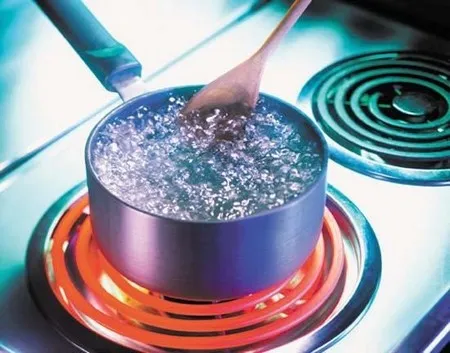Water Vapor & Evaporation
First, let’s go back to basic science. The molecule H2O has many names, depending on its physical state. As a solid, we call it ice, as a liquid, we call it water, and as a gas, we call it vapor. Vapor is really diffused water molecules that appear as fog or mist. When water is heated, the molecules in the water vibrate and some of them escape into the air, thus becoming water vapor, or the gaseous state of water. That’s why we call it eVAPORation. The liquid water becomes a gas known as vapor.
Boiling & Steam
Now, if we continue to heat the water it will reach boiling point, which is about 100℃ (at sea level). Rapidly boiling water makes a bubbling noise due to all the intense evaporation, and you can see big bubbles on the surface of the water. At this point the water can no longer maintain its liquid state and quickly evaporates into vapor. You may have noticed that if you put a pot of water on the stove to boil and forget about it, when you come back later, less water is left in the pot as much of the water will have evaporated.
Steam is a specific kind of vapor that is only produced through boiling. And when steam is created, it also expands. Each liter of water that is boiled will expand to 1600 liters of steam!

Condensation
Whereas evaporation is the transformation of liquid water to gaseous water vapor, condensation is the opposite: it is the transformation of vapor back into liquid water. As we said above, when water evaporates, it expands 1600 times larger in volume to become steam. When it condenses, it compresses back into tiny droplets of water. And we call those tiny droplets of water condensation.

Tea Time
Here’s another way to think about evaporation and condensation. When you boil water in a tea kettle, you know that the water has reached boiling point when the kettle whistles and white smoke starts coming out of the spout. That smoke is not actually steam but rather vapor (though most people would claim it is steam). Steam is an invisible gas, unlike water vapor, which appears as a mist or fog. In the image below, look closely at what’s coming out immediately near the spout. At first you don’t see anything; that’s the steam. And then after the steam are the small white billows of smoke, which is actually the steam condensing back into water vapor (due to contact with the air). In other words, the water inside the tea kettle boils, evaporates in the form of bubbles and comes out of the spout as steam. Then when the steam makes contact with the cold air outside the tea kettle, it quickly condenses back to tiny droplets of water, which you see as water vapor.

Steamy Science Condensed
Let’s review. We learned that water has three states: ice is the solid state, water vapor is the gaseous state, and water is the liquid state. When water is heated it evaporates, which means it turns into water vapor and expands. At 100℃ it boils, thus rapidly evaporating. And at boiling point, the invisible gas of steam is created. The opposite of evaporation is condensation, which is when water vapor condenses back into tiny droplets of water. Those drops of water are called condensation.
Join us in our next post as we apply our understanding of steam to the autoclave. We will answer the following important question: why is steam the best sterilization agent for the autoclave?
(Post based on Sterilization of Medical Supplies by Steam by Jan Huys. Credit for image of boiling water.)